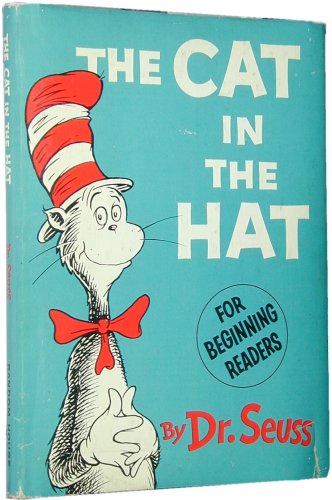|
The birth of a new
genre, influencing a generation of young readers: |
|
|
"I know some good games we could play," Said the cat. "I know some new tricks," Said the Cat in the Hat. "A lot of good tricks. I will show them to you. Your mother Will not mind at all if I do." |
| SEUSS, Dr. The Cat in the
Hat. New York: Random House, (1957). Tall octavo, original pictorial
unglazed boards, original pictorial dust jacket. $8500.
First edition, first issue (with unlaminated boards) in rare first issue dust jacket (with "200/200" price). The Cat in the Hat marks a turning point in early children's readers, introducing a new genre of educational primers that were fun and exciting as well as instructive to children. Dr. Seuss's " next career turning point was in response to Rudolf Flesch’s book and John Hersey’s article, both entitled ' Why Johnny Can’t Read'; the premise for both article and book was that children’s books were boring. Hersey was outraged with the current primers, calling them 'antiseptic' and the children in them 'unnaturally clean.' He called for illustrations 'that widen rather than narrow the associative richness the children give to the words,' and concluded that the work of artists like Geisel and Walt Disney would be more appropriate. So in an unusual act of sharing an author, Houghton Mifflin and Random House asked Ted to write a children’s primer using 220 new-reader vocabulary words; the end result was The Cat in the Hat. Houghton Mifflin reserved textbook rights and Random House reserved retail-trade rights. While schools were hesitant to adopt it as an official primer, children and parents swarmed for copies. Though Ted’s road to children’s books had many twists and turns, The Cat in the Hat catapulted him from pioneer in children’s literature to definitive children’s book author-illustrator, a position he has held unofficially for many decades since" (Seussville.com; Dr. Seuss Enterprises). The Cat in the Hat, in fact, was so successful that Random House created a special publishing division, "Beginner Books," with The Cat in the Hat as the logo and Dr. Suess as president. Book near-fine with light rubbing to edges, rare dust jacket extremely bright and fresh with light rubbing to spine ends and rear panel, and mild crease and small closed tear to front panel. An exceptionally well-preserved copy of a book that is usually found in poor condition. |
